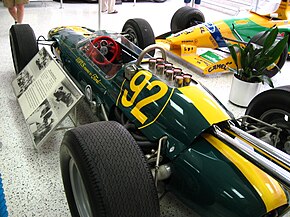Lotus 29
The Lotus 29 was a single-seater - racing cars , which in 1963 Lotus for the 500-mile race at Indianapolis was developed and by 1965 in the USAC series was used.
prehistory
While mid-engine racing cars were predominantly used in the European monoposto series, and especially in Formula 1 , in the early 1960s , front-end engines were still used in US formula racing . A first glimpse of the future of this form of motor sport was given in the United States in 1961 when Cooper brought a mid-engined racing car to Indianapolis for Jack Brabham . It was a Cooper T51 that had a Climax engine bored out to 2.7 liters . Brabham finished ninth with this car in the race.
A year later drove Dan Gurney a Cooper chassis with a V8 - Buick -Motor, but retired at halftime of the race with engine failure. Gurney had never competed for Colin Chapman's team, but he was able to convince the British designer to build an independent vehicle for the 1963 500-mile race .
The racing car
Chapman secured the support of Ford in advance to get a usable engine. Ford already supplied the Watson racing cars that had won the last four 500 mile races. However, these racing engines require methanol as fuel. Chapman wanted an engine for normal racing gasoline and got a 4.2-liter V8 engine from the Ford Fairlane , which was converted into a racing engine. Chapman was sure that he would save fuel with conventional fuel in order to win the race with fewer pit stops. Lotus brought a Lotus 25 to Indianapolis in the fall of 1962 . The vehicle with which Jim Clark had won the US Grand Prix shortly before . The car got the Ford engine installed and both lap times and fuel consumption were so impressive that Ford approved the funding for Project 29.
Chapman brought Len Terry , who had left the team at short notice, back in September 1962 and had the 29 built. Basically the 29 was an elongated Lotus 25 that got reinforced suspensions at the front and rear. The monocoque corresponded to that of the 25th, but the tanks in the car were completely new. Six were necessary to provide the necessary capacity, as the race went over almost 800 kilometers, more than double the Grand Prix distance. Two tanks came on each side of the car, one behind the cockpit, in front of the engine. The sixth, an aluminum tank, was under the driver's feet. Of course, all tanks had to be connected to the engine and special valves ensured that the fuel in the side tanks could not spill from one tank to the other in the banked curves.
The 1963 500 mile race
Lotus brought three chassis to Indianapolis, with Jim Clark and Dan Gurney in the racing cockpits. Clark qualified for fifth place on the grid with an average of 240.948 km / h. Gurney had an accident in the first training session and destroyed a chassis. However, he was able to fall back on the first prototype and started the race from twelfth place on the grid. The strategy of the six tanks should only make a single pit stop necessary and thereby decide the race for Lotus. However, the drivers had to be careful with the tires. The leading Parnelli Jones pits for his first routine stop with his Watson after 62 laps. This automatically put Clark and Gurney in the lead, who had their stops at halftime of the race - 200 laps had to be driven - on laps 92 (Gurney) and 95 (Clark). With that, the Lotus had completed their stops and were now back in second and third place behind Parnelli Jones. The Lotus strategy, however, was undermined by periods of yellow flags - which prevent overtaking - which allowed Jones to refuel twice without losing the lead. After 177 laps, Dan Gurney fell behind due to engine misfires, but Jim Car was only five seconds behind Parnelli Jones. Its Watson pulled a blue trail of smoke behind it and lost oil. The rules in this case clearly stated that a vehicle that lost oil and did not pits should be taken out of the race immediately with the black flag. The officials failed to do so, which ultimately cost Jim Clark a possible win. The vehicles driving behind Jones always had to take their foot off the accelerator in the corners to avoid the oil-smeared spots. As a result, Clark was unable to catch up with the ailing leader. When Eddie Sachs spun on the oil track eleven laps before the end , there were again yellow flags. The race was opened again on lap 193, but Clark was unable to catch up with Jones on the now completely dirty track.
Jones won the race and Lotus protested the result after the end, which was dismissed a few days later. The Indianapolis victory for Jim Clark and Lotus then followed in 1965 with the Lotus 38.
More races
A few weeks later, Jim Clark won the Milwaukee 200 with the Lotus 29 and Dan Gurney came third. It was the first victory for a mid-engined racing car in a USAC series race. Then the cars were sold and were driven by private drivers again in 1964 and 1965, albeit unsuccessfully, in Indianapolis.
literature
- Anthony Pitchard, "Lotus - The Competition Cars," Haynes Publishing, 2006
- Dave Friedmann: Indianapolis, Racing Memories 1961-1969 . Motorbooks, Osceola 1997, ISBN 0-7603-0142-5 .

